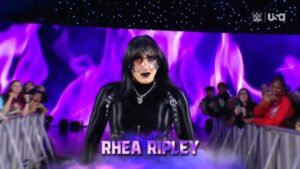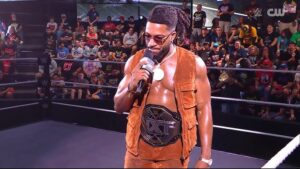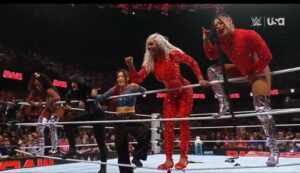The philosopher Baruch Spinoza wrote, “I am human. Nothing of that which is human is alien to me.” As A&E’s Biography spot on Bret “Hitman” Hart displays, it is humanity that lies at the heart of his enduring appeal. At a time when the WWE-or, rather, WWF-and pro wrestling in general was a rogue’s gallery of broad characters, Hart’s immense popularity spun not from a gimmick, but his in-ring prowess and emotional honesty.
The Beginning
The documentary covers a lot of familiar ground for most pro-wrestling fans, beginning with Hart’s childhood in Calgary, Alberta, Canada. He was born into the pro wrestling business, the son of wrestler turned promoter, Stu Hart. As Hart himself recounted in the 2007 memoir Hitman: My Real Life in the Cartoon World of Wrestling, as fortunes with Stu’s Stampede Wrestling Promotion waned and waxed, times were sometimes lean, and the 12 Hart kids faced bullying at school over their father’s profession. However, their offbeat upbringing also came with comradery and pride. Despite experimenting with film-making, Hart found his way into the family business and first tasted television popularity on Stampede’s Saturday afternoon program.
As many of the territorial promoters did, Stu sold his brainchild to the WWF, to Vince McMahon, Jr.
Bret, brother Owen Hart, and trainees of Stu’s infamous submission wrestling lab the Dungeon, Davey Boy Smith and Jim Neidhart, ended up in the WWF. As the tag team, The Hart Foundation, Neidhart and manager Jimmy Hart carried the weight in promos with more outrageous personalities, while Bret’s ring work spoke for itself: fluid, near flawless, but still robust, with an Apollonian ease that sheltered and showcased his opponent, told the story of the match, and grabbed not only the eye of the WWE fans but spoke to their souls.
Hart allowed himself to look cornered and sell his pain, engaging his audience in the ballet of wills between him and his opponent, stirring their emotions, giving them the ultimate pay off when his technical skill won the day. Quite apart from the bodybuilder ideal and cartoonish machismo of the WWE’s first wave of superstars, Bret Hart’s victories looked earned: executed with a true athlete’s knowledge of the game, but pulled off with the favor of whatever higher power chooses heroes, a demigod of the squared circle with a sliver of vulnerability beneath his wiles: Odysseus, on a roster full of Agamemnons and Ajaxes.

Bret Hart: The Singles Performer
As a singles performer, Bret “Hitman” Hart made it even more personal. Severed from Neidhart and Jimmy Hart, Bret’s promos were infused with personal stories about his family, and the pride and skill his upbringing and his father’s tutelage had instilled in him. It struck a different chord than the blistering braggadocio of earlier figures like Hulk Hogan. Hart says in the documentary, “I never yelled at my fans,” and footage of his calm and engaged presence among fans illustrates the two-way connection he cultivated with his public. As a certain streetwise 90s swagger began to seep into his image and ‘Hitman’ character, still he was the kind of champion that young kids felt comfortable chatting with on a visit to their school.
Family became more and more a staple of Hart’s WWE storylines, and he fondly recounts the lead-up to 1992’s SummerSlam, in which he faced brother-in-law Smith, The British Bulldog, for the Intercontinental Championship. The Hart family played along, acting out the tale of a fractured family torn apart along drawn lines, either for Hart or for Smith, and the culminating match on the day itself, at Wembley Stadium, is high drama: one woman, Diana Hart Smith, watching pensively as her brother and her husband trade blows over gold and glory. The relatable tensions of family-egos, resentments, arguments, taking sides-spoke universally, and continued with another storyline, in which younger brother Owen Hart was hell bent to prove himself better than his older brother in every way possible.
It was a culmination of a boyhood storyline dreamed up between the two.
The documentary covers these heights exuberantly, and gracefully handles the darker days of Bret Hart’s life with grace and respect: the financial tug of war for Hart between McMahon and rival promotion WCW, the ugly personality conflict between Hart and Shawn Michaels, the death of his brother, Owen, due to faulty equipment part of a botched stunt at a pay per view in 1999, and the event with which his name will always be linked: Survivor Series 1997, in Montreal, Quebec, Canada.
Footage from the documentary Wrestling With Shadows is shown in which Hart seems to be given creative leeway on how he wants to rescind his WWF championship, and it is not rival Michaels. However, this was the ending that played out in front of a Canadian crowd that still idolized their native Odysseus, the wily gladiator who, heel or babyface, at least tried to keep it real, as McMahon demanded that the bell be rung on the match while Hart was maneuvering out of his own finisher, the Sharpshooter, applied by Michaels.
On the next week’s Raw, McMahon insisted, “Bret screwed Bret.”
On the other hand, Hart’s niece, WWE Women’s tag team champion Natalya looks defiantly into the A&E camera and says, “Bret did not tap out.”
Whatever really occurred in Montreal, Bret “Hitman” Hart was already on his way out, having signed with WCW, but landed there visibly dispirited, finding the company a shambles. A match with Goldberg, the former football player whose training in pro wrestling was negligible and who approached every match with dangerous force, left Hart with a concussion so severe he was forced to retire. A stroke followed a couple of years later, and footage of Hart’s rehab shows his determination to recover. Speaking of this time, he is candid about his dejected frame of mind at this time, over the stroke, WCW, his divorce and failings in his first marriage, and his lingering anger and bitterness about “The Screwjob.”
The memory of his brother Owen, however, rallied Hart to love the craft of pro wrestling once again, and to reach out to McMahon to bury the hatchet, and put the past behind him with Michaels, as well. The Hart who returned to Raw, and faced McMahon at Wrestlemania 26 in 2010 was neither the swaggering Hitman or the virtuoso of technical wrestling that his fans had been so enamored of in the late 80s and 90s. He’d danced a hard tango with loss, injury, misadventure and time, and come out of it a performer with physical limitations who’d returned to do just one thing: put the past to bed, and connect with fans who still cared. Never more vulnerable, and never more compelling to those who had missed his presence in the business he was born into, pro wrestling.

A&E Biography: Bret “Hitman” Hart – In Closing
As the documentary winds down, the camera turns to Hart’s life now: a content grandfather, who has reconnected with his adult children, and found love again with current wife Stephanie Washington-Hart.
Family. Creativity. Ambition. Success. Loss. Depression. Health crises, and recovery. Divorce, and finding love once more. Nothing that is human is left out of the story of Bret “Hitman” Hart, and A&E’s Biography presents it with respect and stirring earnestness.
Stay tuned to the Last Word on Pro Wrestling for more on this and other stories from around the world of wrestling, as they develop. You can always count on LWOPW to be on top of the major news in the wrestling world, as well as to provide you with analysis, previews, videos, interviews, and editorials on the wrestling world. Ultimate Warrior fan? You can check out an almost unlimited array of WWE content on the WWE Network and Peacock.
Looking to talk wrestling, pro football, or any number of sports? Head on over to the LWOS Boards to engage in conversation with fellow fans!






